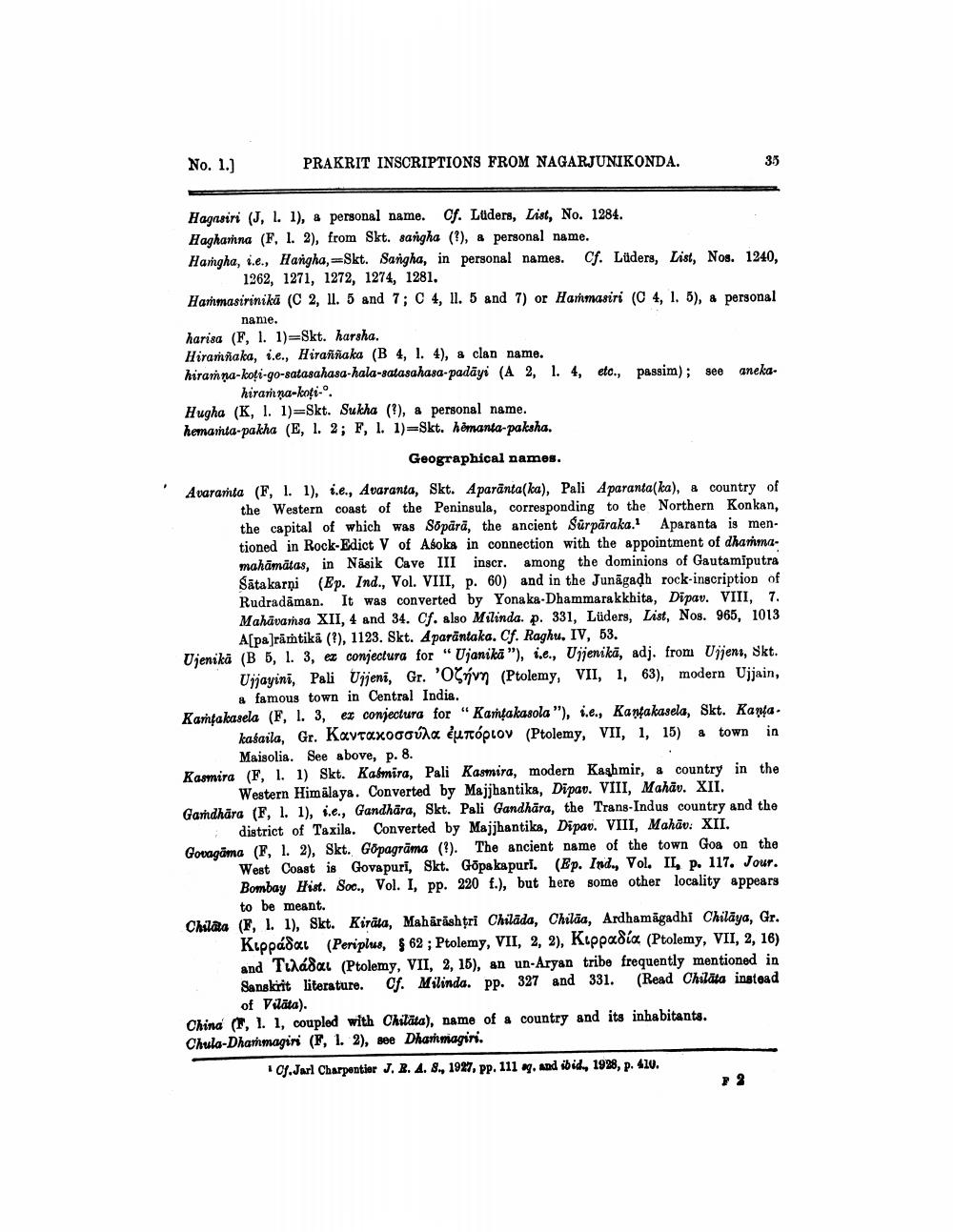________________
No. 1.)
PRAKRIT INSCRIPTIONS FROM NAGARJUNIKONDA.
35
Hagnsiri (J, I. 1), a personal name. Cf. Lüders, List, No. 1284. Hagharna (F. 1. 2), from Skt. sangha (?), & personal name. Hangha, i.e., Hangha, Skt. Sangha, in personal names. Cf. Lüders, List, Nos. 1240,
1262, 1271, 1272, 1274, 1281. Hammasirinika (C 2, 11. 5 and 7; C 4, 11. 5 and 7) or Hammasiri (C 4, 1. 5), & personal
name. harisa (F, 1. 1)=Skt. harsha. Hiramnaka, i.e., Hiraññaka (B 4, I. 4), & clan name. hiran na-koti-go-satasahasa-hala-satasahasa-padayi (A 2, 1.4, etc., passim); see aneka
hiran na-kotiHugha (K, I. 1)=Skt. Sukha (?), a personal name. hemanta-pakha (E, I. 2; F, l. 1)=Skt. hômanta-paksha.
Geographical names. Avaranta (F, I. 1), i.e., Avaranta, Skt. Aparänta(ka), Pali Aparanta(ka), a country of
the Western coast of the Peninsula, corresponding to the Northern Konkan, the capital of which was Sopārā, the ancient Sürparaka. Aparanta is mentioned in Rock-Edict V of Asoka in connection with the appointment of dharmamahāmatas, in Nasik Cave III inscr. among the dominions of Gautamiputra Satakarni (Ep. Ind., Vol. VIII, p. 60) and in the Junāgadh rock-inscription of Rudradāman. It was converted by Yonaka-Dhammarakkhita, Dipav. VIII, 7. Mahāvarnsa XII, 4 and 34. Cf. also Milinda. p. 331, Luders, List, Nos. 965, 1013
A[pa]rātikā (?), 1123. Skt. Aparantaka. Cf. Raghu, IV, 53. Ujenikā (B 5, I. 3, ez conjectura for “Ujanikā "), i.e., Ujjenikā, adj. from Ujjens, Skt.
Ujjayini, Pali Ujjeni, Gr. 'Olymn (Ptolemy, VII, 1, 63), modern Ujjain,
a famous town in Central India. Kamtakasela (F, 1.3, ex conjectura for "Kantakasola"), i.e., Kantakasela, Skt. Kanta.
kaśaila, Gr. Kavraxosoúha čutóplov (Ptolemy, VII, 1, 15) : town in
Maisolia. See above, p. 8. Kasmira (F, I.1) Skt. Kalmira, Pali Kasmira, modern Kashmir, #country in the
Western Himalaya. Converted by Majjhantika, Dipar. VIII, Mahāv. XII. Gandhára (F, l. 1), i.e., Gandhāra, Skt. Pali Gandhära, the Trans-Indus country and the
district of Taxila. Converted by Majjhantika, Dipav. VIII, Mahāv. XII. Govogūma (F. 1. 2), Skt. Gopagrāma (). The ancient name of the town Goa on the
West Coast is Govapuri, Skt. Göpa kapuri. (Ep. Ind., Vol. II, p. 117. Jour. Bombay Hist. Soc., Vol. I, pp. 220 f.), but here some other locality appears
to be meant. Chilaa (F, I. 1), Skt. Kirata, Maharashtri Chilada, Chilāa, Ardhamagadhi Chiläya, Gr.
Kuppádat (Periplus, $ 62 ; Ptolemy, VII, 2, 2), Kippadia (Ptolemy, VII, 2, 16) and T ádat (Ptolemy, VII, 2, 15), an un-Aryan tribe frequently mentioned in Sanskrit literature. Cf. Milinda. pp. 327 and 331. (Read Chilata instead
of Vilāta). China (E, 1. 1, coupled with Chitāta), name of a country and its inhabitants. Chula-Dharmagiri (F, 1. 2), bee Dhanmagiri.
cf.Jarl Charpentier J. R. A. 8., 1927, pp. 111 . And ibid., 1928, p. 410.




